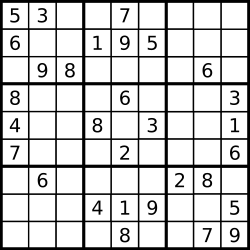Write a program to solve a Sudoku puzzle by filling the empty cells.
A sudoku solution must satisfy all of the following rules:
Each of the digits 1-9 must occur exactly once in each row.
Each of the digits 1-9 must occur exactly once in each column.
Each of the the digits 1-9 must occur exactly once in each of the 9 3x3 sub-boxes of the grid.
Empty cells are indicated by the character '.'.
Note:
The given board contain only digits 1-9 and the character '.'.
You may assume that the given Sudoku puzzle will have a single unique solution.
The given board size is always 9x9.
Hard,给一个99的矩阵,其中每行每列和各33的小区域中有预先填写一些数。要求将剩下的空格填完,满足数组的要求。
一个思路就是使用DFS,当遇到一个空格,查看其行、列和小区域的其他值,确定可以填的数,填入一个之后进入下一个空格,如果这样下去可以成功直接结束算法。如果中途某个空格发现无法填数,则表示失败,返回上级递归。
代码如下:
Runtime: 28 ms, faster than 26.39% of C++ online submissions for Sudoku Solver. Memory Usage: 13.8 MB, less than 14.64% of C++ online submissions for Sudoku Solver.
class Solution {
public:
void fillableVal(vector<char> &tmp, vector<vector<char>>& board, int row, int col){
bool val[9] = {true, true, true, true, true, true, true, true, true};
int li, lj;
// col
for(int i=0; i<9; i++){
if(board[i][col]!='.') val[board[i][col]-'1'] = false;
}
// row
for(int j=0; j<9; j++){
if(board[row][j]!='.') val[board[row][j]-'1'] = false;
}
// local area
li = (row / 3) * 3;
lj = (col / 3) * 3;
for(int i=0; i<3; i++){
for(int j=0; j<3; j++)
if(board[li+i][lj+j]!='.') val[board[li+i][lj+j]-'1'] = false;
}
tmp.clear();
for(int i=0; i<9; i++){
if(val[i]) tmp.push_back('1'+i);
}
return;
}
bool SudoKu(vector<vector<char>>& board, int row, int col){
if(col==9) {
row += 1;
col = 0;
}
if(row>=9) return true;
if(board[row][col]!='.') return SudoKu(board, row, col+1);
vector<char> tmp;
int len;
fillableVal(tmp, board, row, col);
len = tmp.size();
for(int k=0; k<len; k++){
board[row][col] = tmp[k];
if(SudoKu(board, row, col+1)) return true;
}
board[row][col] = '.';
return false;
}
void solveSudoku(vector<vector<char>>& board) {
SudoKu(board, 0, 0);
return;
}
};BitBrave,2019-05-23

